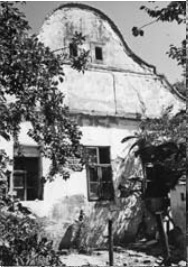The house was erected in the first half of the 19th century and is located in the old part of the settlement in the immediate vicinity of the Serbian Orthodox Church. It is located in the north-south direction and belongs to the developed type of Pannonian house built from a charge, with the pronounced decorative elements of the provincial Baroque. Many interventions were carried out on the building over the course of time, and today’s appearance was most likely obtained at the beginning of the 20th century. In the sixties, an inadequate change was made on the street facade, which made the building devastated much.
Rectangular is the base, with a street facade drawn on the control line. The façade canvas is flat with three window holes with the “T” partition of the windows, and the street gable only kept its pseudo-baroque appearance in its final line. Two rooms are oriented towards the street, of which the smaller part is actually a part of the closed porch, which was closed in the first major adaptation at the beginning of the 20th century. From the yard entrance goes to the entrance hall, and to the right in the room that serves as a storeroom, while from the centrally located kitchen goes to the front and back room. All rooms are patosane. The house has a high fenced yard and old amber from the same time. It was originally covered with reed, and today the roof cover is a red falcated tile.
In this house, on which major changes were made, he was born on March 31, 1826, in a poorly crafted family, painter and writer Novak Radonic. In the village of Molu he finished elementary school. He started studying at the Gymnasium in Szeged, but his father for acquiring painting education sent him to Sent, to the workshop of painter-painter Petar Pilić. In 1850, Radonic moved to Arad, where he entered the workshop of Nikola Aleksic, who then belonged to the circle of our most famous and prolific portraits. After a year of work with Aleksic, Radonic went to Vienna where in the class of Professor Karl Heinrich Rahl from 1851/56. He graduates from the Academy and returns to Novi Sad. In 1858, saving some money earned his great desire to go to Italy where he was attracted by works of great masters. He travels to Venice, Florence, Rome and Naples.Even as he worked with KH Rala, watching his numerous monumental compositions with a lot of figures on the move, Radonić felt uncertainty in his own painting abilities. Returning from Italy, there are again old doubts in their own values, and somehow at the same time, his first literary works are going to be born, which he will deal with for the rest of his life. He published the first articles in 1878 under the title “Molly Mudrovanja”. At that time, after the address of Dr. Jovan Subotic for the iconostasis for the church in Srbobran, in 1863, he received an order to paint the iconostasis in the SPC in Ada, about which a note was published in “Danica” in which they are congratulated to the Ađani that they were able to assemble contract with Radonic. Though he is at the same time the most sought-after portraitist, his doubts about his own painting possibilities are so expressed that he thinks to finally leave painting.
His third contracted work on painting the iconostasis Ilandzi accepted only from material troubles, but after painted five icons, he left the further painting to Aksentia Marodic. He died on May 30, 1890.
In his painting work, he passed through several stages of painting development, and best expressed himself as a portraitist. In the field of church painting he showed dependence on church templates, while he took a special place in Serbian artistic romanticism with historical-allegorical compositions.
In 2005 Novak Radonic’s birthplace collapsed to the ground.
Birth House of Novak Radonić


0 comments on “Birth House of Novak Radonić”